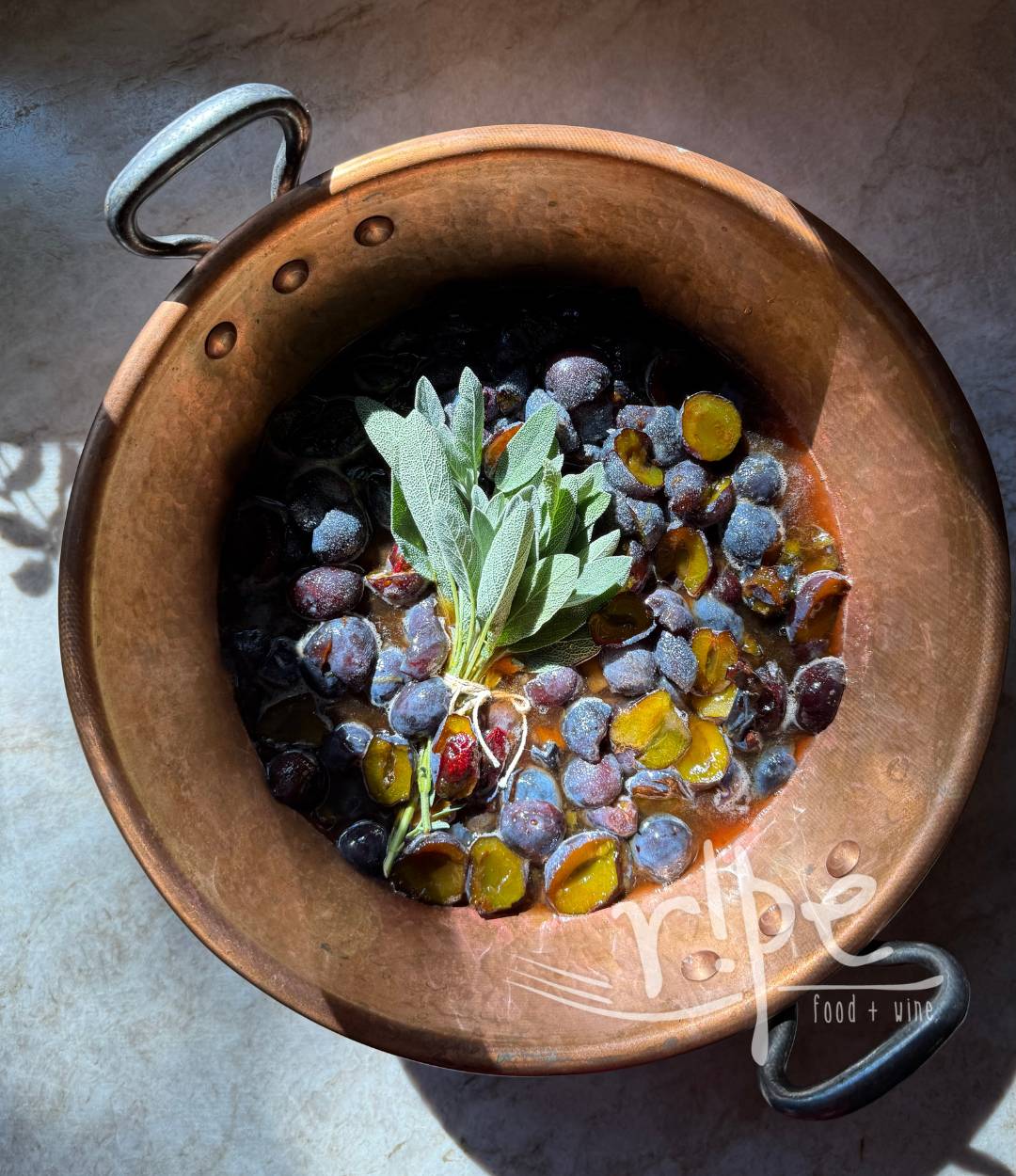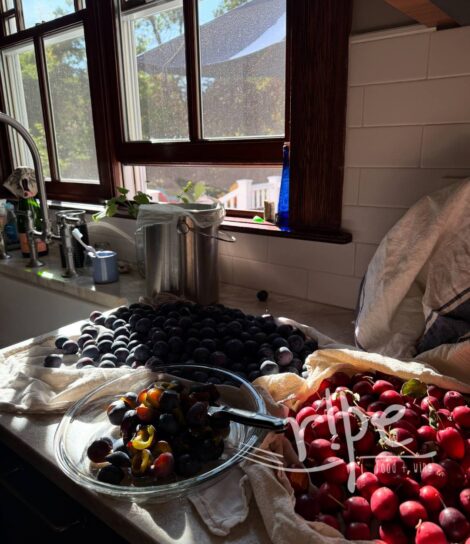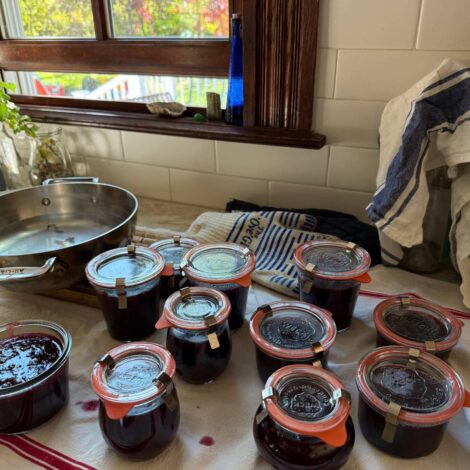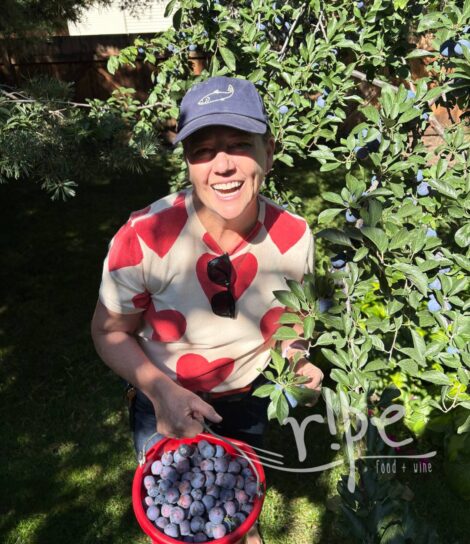You can certainly make jam without embarking on the whole canning process, but it is nice to have a recipe that actually works for such down-home preserving projects. For simple plum jam that you cook then keep in the refrigerator, see my recipe on Edible Bozeman.
I don’t like jams that are too sweet, but when you’re making jam without added pectin, you need a certain amount of sugar to get the right consistency and to prevent spoilage, especially when you’re canning versus keeping what you make in the refrigerator or freezer. For this recipe, I bring the sugar down to what I think is the bare minimum and accept a looser texture.
When making a jam you intend to can, you don’t want any harmful bacteria in your jam or on your jars or lids or spoons, so it’s essential that you follow canning recommendations from your jar manufacturer (I use Ball and Weck) and/or modern research-based guidelines, like these resources from Montana State University and the National Center for Home Food Preservation at the University of Georgia.
Before I scare you off from what is a fun and rewarding project, remember that grandmothers have done this for a long time and jams are one of the safest things to preserve due to the sugar and acidity. For this recipe, I used Damson plums from a friend’s tree here in Bozeman, Montana.
My small red bucket of plums yielded 10 pounds of fruit (8 pounds pitted). I used 4 pounds to make this jam and froze the remaining in 2-pound packages for simple sauces on the stovetop or in the oven this winter. To control acidity (and to avoid using bottled lemon juice because I just don’t like it), I used powdered citric acid. To infuse the sage, I made sure the sprigs were clean and dry and added them at the beginning of the jam’s cooking.
Damson Plum Jam with Sage
4 pounds pitted plums yielding 10–12 small jars of jam (about half-pint size); recipe adapted from "Homemade Plum Jam" by J. Kenji López-Alt on SeriousEats.com
Ingredients
Macerate overnight in non-reactive bowl, refrigerated
- 4 pounds pitted plums
- ½ lemon, juice squeezed over the plums
- 3 cups granulated sugar
for cooking the jam
- macerated plums
- 2½ teaspoons citric acid powder or 5 tablespoons bottled lemon juice
- 2 pinches Maldon salt or other salt
- 1 bundle fresh sage sprigs washed, dried, and tied with kitchen twine
Instructions
Prep your equipment
-
Clean your jars and lids in hot soapy water and allow to air dry on a clean kitchen towel. In the same way, clean ladle, spoon, funnel, and anything that will touch the jam during processing.
-
In medium pot or frying pan, place lids and rubber seals (if using Weck, place two clamps on each lid and rubber seal, kind of a balancing act but it does make placing the rings and lids on the jars easier), add water to cover, bring to boil and boil 10 minutes to sterilize then leave in the hot water until use.
-
Fill canning pot with water, cover, and bring to boil. Turn off heat while you make the jam.
Cook, Jar, and Process
-
Scrape contents of the bowl used to macerate the plums into a large Dutch-oven or copper jam pot. Add citric acid (or bottled lemon juice), sage sprig, and bring to boil. Lower heat to a gentle bubbling and cook for 15 minutes, at which point taste the sage infusion. If it tastes good, remove the sage and continue cooking the jam for 10 additional minutes (grand total of 25 minutes).
If sage infusion is not strong enough for your liking, keep it in the jam for some or all of the final 10 minutes of cooking.
-
Ladle jam into jars, seal with canning lids (two-piece metal lids and rings or the Weck system which uses rubber rings, glass lids, and two metal clamps per jar).
-
Lower jars into the hot water canning pot (as many as will fit in a single layer unless you have a pot with a stacking rack, in which case you can go double-decker) and bring back to a rolling boil. Process for 10 minutes at sea level, additional 10 minutes for Bozeman elevation (approx. 5,000 feet).
Recommended adjustments for high-elevation are on the Ball Canning site—add 5 minutes per 3,000 feet elevation.
-
Remove jars from water canning pot using jar tongs and set on a rack over a kitchen towel to remain undisturbed until cool. Don't worry about condensation you may see on the underside of the Weck lids, it is normal and usually reabsorbs into the jam.
-
When jars are completely cool, check the seals—metal lids should have suctioned down and you won't feel any give if you press the top with your finger; for Weck lids, remove the metal clasps and lift the jar from the lid, if it stays connected, you're good. If you have any failed seals, just keep that jar of jam in the refrigerator and enjoy it, no biggie.
-
Label your creations and give them away or keep stored. Use within a year for best flavor. Before eating, check the seal; you don't want to see any leakage or mold on or in the container, if ever you do, throw it out.






